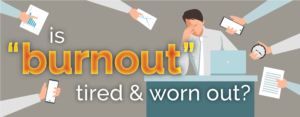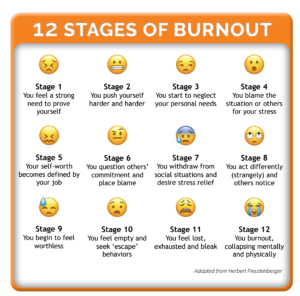
 Tracy LaLonde, Chief Joychiever |
I recently attended a conference about attorney engagement and had many conversations about burnout. During one of those discussions, we pondered if the word ‘burnout’ has become overused to the extent that it is losing or has lost its impact.
I certainly hope this isn’t the case. While many more people are talking about burnout, the conversation in the legal industry, in my opinion, has only just begun. In fact, we should be talking about it MORE. Additionally, many people think burnout is about exhaustion, but, in reality, it is much more complex.
What is Burnout?
Burnout was coined as a term in the 1980’s, and vigorous research began in that era. In its simplest form, it is unresolved chronic stress. Prior to 2020, burnout rates hovered around 43%—meaning almost half of all workers experienced symptoms of burnout. During the pandemic, rates shot up to 70-80% and is currently reported at 52% generally and at 63% in the legal industry.
There are three components of burnout:
- Exhaustion: Profound physical, cognitive and emotional fatigue resulting from workload, work pace, always-on pressure and a lack of control of work.
- Detachment or cynicism: Increased mental or emotional detachment from the job, often including feelings of negativity or distrust. High conflict, unfairness and/or a lack of participation in decision making or a mismatch of values between the individual and the organization contribute to detachment.
- Inefficacy: A feeling of incompetence or lack of achievement or productivity. It can occur when job skills have slipped or become irrelevant or there is a lack of support, resources or information to do the job well.
You can experience any or all of these elements to start feeling the burn or stress.
Over the years, researchers and psychologists have been peeling back the layers of the burnout onion to discover that there are three burnout sub-types:
- The frenetic type: This person is ambitious—maybe even a workaholic, has a high need for achievement and prioritizes hard work above all else. When faced with challenges, they will invest more time and increase effort to get through.
- The “bore-out” type: This person is unstimulated and under-challenged at work. They only put in as much effort as necessary to complete a task and nothing more. The extreme feeling boredom, aka “bore-out”, leads them to seek other, more gratifying jobs.
- The worn-out type: This person feels an extreme lack of control. The policies and procedures, lack of resources, and lack of reward at work paralyze them to the point of giving up entirely. They feel neglected and ultimately resign as a way to cope with the stress.
Do you fall into one of these types?
The Path to Burnout
While the realization that you are suffering from burnout may feel like flipping a switch, e.g. “I’m burned out,” it actually is a long, twisting journey to get to the state.
Herbert Freudenberger, the psychologist, author and researcher who coined the term burnout in 1980, developed the 12 stages of burnout. I like to think of it as a “Where’s Waldo?” type of map. At what stage might you be?

At the height of my burnout journey, I made it to Stage 11. Now, it’s not something I’m proud of. In fact, I find it quite sad. I knew I was stressed and unhappy, but it took me a long time finally do something about it—to make changes in my work life to put myself first and care for me.
Now, I like to use this model to assess where I am and to not let it get out of control. I engage in all sorts of self-management behaviors to prevent me from getting too far along, and when I notice myself creeping into Stage 3, I step up my efforts so it doesn’t go any further.
Quick Pulse Poll
In addition to the 12 Stages of Burnout, here is a quick pulse poll that you can take to assess your stress state. Grab a pen and rate how often you have had any of these experiences over the last month? (1= not at all, 3=frequently, 5=all the time)
- I am unable to complete tasks on time.
- I lose track of tasks and time.
- I am moody and irritable with those around me.
- I feel tired, even when I get good sleep.
- I am unsatisfied with previously enjoyed tasks or activities.
- I am experiencing minor unexplained physical ailments.
- I use busyness as an excuse for canceling the fun aspects of my life.
- I am withdrawing from my team and don’t participate much in meetings.
- I am having sleep problems.
- I chronically work during personal hours.
Burnout manifests itself in many individual ways, but if you want a quick way to check your burnout “pulse,” consider this list. Examine how often any of these items occur for you each month, as well as look at how many of them are occurring regularly for you. While there is no exact science, you may want to do further self-exploration if your frequency rate is high for a number of these items.
Stay Vigilant
Whether you are experiencing burnout or not, you must stay vigilant to its prevention. Unfortunately, burnout is alive and thriving among lawyers. If you’ve suffered from it, you need to continue to do the work to avoid not falling prey to it again. If you have been one of the luckier ones to not have felt it, be on the lookout for any symptoms so you can nip it in the bud before it gets too far.
With three decades as a captivating public speaker and engaging trainer, Tracy LaLonde works with firms in two areas: 1) Helping high-achieving individuals discover their true selves, empower their joy, and apply their ambition to attaining sustainably blended, happy lives, while pursuing personal success and business results; and 2) Educating leaders to avoid common pitfalls of burnout, deploy best practices for retention and create a workplace where people want to work, stay and prosper.
